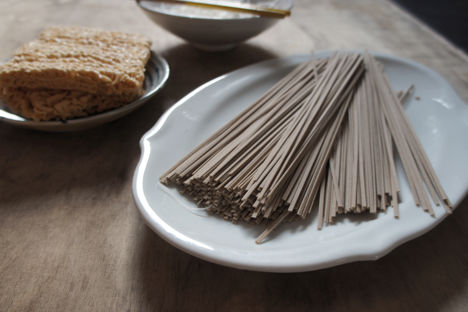
Flavours of Japan: noodles
Shu Han Lee extols the virtues of shirataki, ramen and soba noodles, with quick, simple recipes that you can use to try each of them at home.
Flavours of Japan: noodles
Shu Han Lee extols the virtues of shirataki, ramen and soba noodles, with quick, simple recipes that you can use to try each of them at home.
I’m a noodles fiend and have two whole shelves in my kitchen cupboard dedicated for the many types of noodles that I own. Even so, I’ve barely scraped the surface when it comes to noodles. Noodles can come in all manners of shapes, widths and thicknesses; and be made from all sorts of ingredients including rice, wheat, mung bean, and sweet potato starch… The list goes on. The various shapes and ingredients give each type of noodle its characteristic taste and texture, so I never get bored cooking with noodles. None is a favourite since every one of them is special and suit different preparations.
Having grown up in Singapore, I tend to reach for the rice and egg noodles more often but there are others that I turn to when I fancy something different. The three that I’m sharing today are some of my favourites for quick, fuss-free cooking:
Shirataki
These noodles are the latest health craze to hit the world of green juices and gluten-free bread. Often marketed as ‘zero-calorie, zero-carb’ noodles, shirataki noodles are made from glucommanan starch that’s extracted from devil’s tongue yam – an indigestible dietary fibre that pretty much passes straight through your body. The reasons I like this noodle hardly stem from a desire to lose weight though. I love the beautiful translucent strands, slippery gelatinous texture, and the way they readily absorb flavours.
Shirataki noodles are mostly available pre-cooked in packets, making preparation especially easy. You simply drain and rinse well to get rid of the flavour of the liquid they’re packed in. They are then perfect for tossing into cold noodle salads or slipped into simmering broths. Because shirataki noodles are pretty much flavourless on their own, you can go all out and pair them with punchy, exciting flavours. I love them with spicy bold sauces in a cold noodle salad, particularly during summer.
Ramen
Yet another food trend taking London by storm, ramen are Chinese-style wheat noodles, often served in a rich pork or chicken-based broth. Ramen’s gained a reputation for being notoriously difficult to perfect; sparking debate from noodle lovers about the merits of various ramen restaurants. There is another sort of ramen though, that have a quite different reputation for being cheap, quick and definitely not gourmet, and that’s the one I want to talk more about – instant ramen.
The invention of instant ramen has probably been the pivotal point in getting everyone slurping these Japanese noodle soups. I’m guilty of late night ‘emergency’ ramen myself, but the introduction of healthier non-fried versions and even organic ones have meant I’m no longer hiding my empty packets in shame. Growing up, my Mum’s sometimes resorted to instant ramen on the request of her children and their voracious pubertal appetites, but she’s insistent on ensuring we ate a wholesome meal nonetheless. This gave birth to one of my favourite noodle dishes, the pimped-up ramen – instant noodles served in a quick homemade broth, topped with a poached egg and laden with bits and bobs of vegetables from the fridge.
Soba
Made primarily from buckwheat, soba has a wonderful nutty flavour that’s delicious enough to be eaten on its own with nothing more than a dash of soy sauce and dashi or mirin. In any case, I always keep to simple flavours and minimal ingredients when cooking with soba noodles. While the most popular way of eating soba is chilled in a dipping sauce, they are extremely versatile and can also be enjoyed in hot soups or tossed in a salad.
The most traditional soba noodles are made entirely of buckwheat (called juwari soba in Japanese), which means it’s great news for those on a gluten-free diet. Be careful though, as many of the soba noodles available today are made with a small proportion of wheat flour to give it a lighter, more elastic texture.


